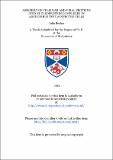Assembly of cellular and viral proteins into nucleoprotein complexes in adenovirus type 2 infected cells
Abstract
The adenovirus type 2 origin of DNA replication is located within the terminal 51 bp of the viral genome and contains three recognisable domains: the minimal origin or 'core' and binding sites for the cellular transcription factors Nuclear Factor I and Nuclear Factor III. Initiation of Ad2 DNA replication is preceded by the assembly of a nucleoprotein complex at the viral origin of DNA replication. Recombinant baculoviruses were previously constructed which express full-length Nuclear Factor I (NFIFL) or its DNA binding domain (NFTDBD) for use in experiments. DNase I footprinting experiments were carried out to examine the cooperative interaction between NFI and DBP. DBP can increase the binding affinity of both NFIFL and NFTDBD for their recognition site in the Ad2 origin of DNA replication. Mini-columns containing NFIDBD covalently linked to CNBr-activated Sepharose were used to demonstrate that the adenovirus DNA polymerase (pol) interacts with NFI on its own and as part of the precursor terminal protein (pTP)-pol heterodimer. Immunofluorescence experiments have shown that NFI is specifically targeted to sites of ongoing viral DNA replication in Ad2 infected cells but not in Ad4 infected cells. This localisation of NFI to discrete subnuclear sites reflects the requirement for NFI for efficient initiation of Ad2 DNA replication. The viral transcriptional activator Ela is also localised to discrete subnuclear sites which are very different from those of DBF and are cell cycle dependant. Antibodies to RNA polymerase II show that although its cellular distribution is also cell cycle dependant it is different from both DBF and Ela. When the sites of active transcription were labelled in Ad2 infected cells they were shown to be distinct from both the Ela and RNA polymerase II nuclear distribution.
Type
Thesis, PhD Doctor of Philosophy
Collections
Items in the St Andrews Research Repository are protected by copyright, with all rights reserved, unless otherwise indicated.

